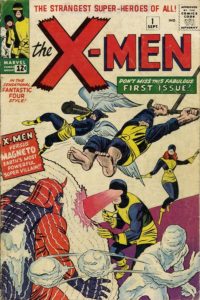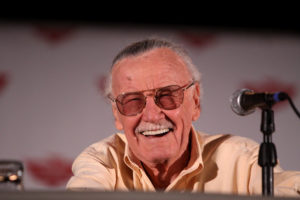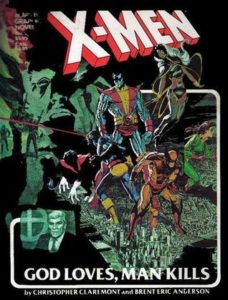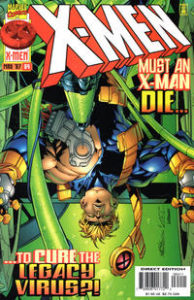In 1963, the United States was hitting a breaking point.
Since the end of the Civil War, “separate but equal” Jim Crow laws — segregation policies that enforced social and economic oppression against Black Americans for nearly a century — were being increasingly challenged by a series of nationwide protests: sit-ins at public parks, libraries, museums, and drugstore lunch counters; bus rides through the Deep South to test recent anti-segregation rulings. In August 1963, despite activists receiving threats of bombings and assassinations, close to 250,000 people marched on Washington D.C. on behalf of economic and civil rights for people of color. Less than two weeks later, a different type of document was published; not by Congress, but a company called Marvel.
It was a comic book about a race of people who, because of their genetic makeup, were considered second-class citizens, either to be taken advantage of or exterminated. Among these mutant outcasts, several had banded together to form a powerful team of heroes that worked towards peace and equality for all humans in a world marked by strong anti-mutant bigotry. They were called The X-Men.

“Normal people feared me, distrusted me! I realized the human race is not yet ready to accept those with extra powers,” the group’s leader, Professor X, explains to new recruit Jean Grey in the first issue. “Here we stay, unsuspected by normal humans, as we learn to use our powers for the benefit of mankind … to help those who would distrust us if they knew of our existence.”
At the time, X-Men creators Stan Lee and Jack Kirby may have simply wanted to introduce characters who didn’t require a complex explanation for how they got their powers: “I couldn’t have everybody bitten by a radioactive spider or zapped with gamma rays, and it occurred to me that if I just said that they were mutants, it would make it easy,” Lee said in a 2000 interview with The Guardian. “Instead of them just being heroes that everybody admired, what if I made other people fear and suspect and actually hate them because they were different? … It was a good metaphor for what was happening with the civil rights movement in the country at that time.”
But Lee and Kirby were also no strangers to struggles for civil equality.
Born Stanley Lieber and Jack Kurtzberg, both men came from working-class Jewish immigrant families in Manhattan and helped the U.S. Army fight Nazis during World War II. In the back pages of most comic issues beginning in 1967, Lee started writing a monthly column he titled, “Stan’s Soapbox,” which he used to preview upcoming characters, playfully provoke other comic publishers, and comment on real-world events. In his column, Lee would call out bigotry and racism as “among the deadliest social ills plaguing the world today” and that “it’s totally irrational, patently insane to condemn an entire race…”

Despite originally going out of print in 1970, the comic was later resurrected and continued to break barriers. In 1975, an “All-New, All-Different” X-Men team (which Marvel’s management intentionally aimed at appealing to international readers) introduced a diverse cast that featured a Harlem-born, Kenyan-American goddess of weather (Storm); a solar-powered Japanese freedom fighter (Sunfire); a Native American former marine (Thunderbird); an atheist Soviet pacifist and painter (Colossus); an Irish former Interpol agent (Banshee); a teleporting German Catholic ex-circus performer (Nightcrawler); and a gruff, cigar-chomping Canadian (Wolverine).
It was essentially a brand new team, itself developed by a brand new team, with then-24-year-old Chris Claremont at the helm as lead writer. The British-born Claremont knew what it felt like to be an outsider in America and brought the notion of prejudice to the forefront. “The X-Men are hated, feared, and despised collectively by humanity for no other reason than that they are mutants,” Claremont said in 1981. “So what we have here, intended or not, is a book that is about racism, bigotry, and prejudice.”
It was Claremont who connected Professor X’s dream of mutants and humans peacefully coexisting alongside the dream of Martin Luther King Jr. He also made longtime X-Men adversary Magneto a survivor of the Holocaust, which gave some justification to the character’s anger and distrust of humanity. (Though it would be later, via a line of dialogue from the first X-Men movie in 2000—“by any means necessary”—that would help align Magneto closer to Malcolm X.) “If they are willing to give my dream a chance, then so am I,” Professor X tells Magneto in X-Men: God Loves, Man Kills. “But should you fail,” Magneto cryptically warns the X-Men later in the graphic novel, “it will be my turn.”

Written by Chris Claremont in 1982, X-Men: God Loves, Man Kills represented a turning point in the pop culture identity of The X-Men. As the 1970s became the ‘80s and the 20th century wore on, the comic came to encompass another human rights struggle: the rising LGBTQ+ movement and queer culture in the United States. In the critically acclaimed graphic novel, a fire and brimstone preacher named William Stryker uses televangelism to wage war against the X-Men, declaring all mutants to be “an affront” to God. Stryker’s goal is the mass extermination of all mutants; even after foiling his literal plans of violence, the X-Men are still forced to defeat the preacher using words instead of superpowers to combat his message of human supremacy on national television: “If we don’t stand up to [Stryker’s beliefs] — here and now — then all we’ve done is delay an inevitable holocaust,” says Cyclops.
Like the “Lavender Scare” of the 1940s and ‘50s, which created a moral panic in the United States about gay men and lesbians being supposed communist sympathizers and risks to national security, Stryker attempts to convince his audience that mutants pose a similarly invisible threat against the rest of the “common folk[s]” of the population.
In 1993, Marvel introduced the Legacy Virus.
It was a devastating plague that disrupted the production of healthy cells in mutants, resulting in fatigue, fever, bad cough, skin lesions, and, eventually, death. A thinly veiled comparison to the HIV epidemic and AIDS crisis, the Legacy Virus was nicknamed “the mutant plague” and first produced in the comics as a weapon created against mutants.
Fears surrounding the Legacy Virus lead to bigger confrontations between humans and mutants (homo sapiens and “homo superior,” as described in the comics). Behind the scenes, longtime X-Men ally and nonmutant Moira MacTaggert worked on developing a cure for the Legacy Virus—though ultimately, it’s only after non-mutant humans become diagnosed with the Legacy Virus is a cure discovered for the disease.
A “cure” for the mutant gene is the focus of the third film in the original X-Men film trilogy, 2006’s X-Men: The Last Stand, which pits the X-Men against an army of mutants assembled by Magneto over what many believe to be the eventual forced extermination of the mutant race. “It’s abhorrent to me, as it would be if a person said I needed curing of my sexuality, or if someone said that Black people could take a pill that would ‘cure’ them of being Black,” said actor Ian McKellen, who was originally attracted to the role of Magneto because of the parallels between X-Men and the struggle for gay rights. Many elements of the X-Men film franchise, from the comic storylines used to inspire the screenplays to the depiction of mutants, have helped to symbolically serve as a queer parable. In the first X-Men movie, a Senate hearing, which is being held to determine whether or not mutants are dangerous, quickly descends into a call for mutant registration to allow Americans “to decide whether they want their children … to be taught by mutants,” among other reasons. When Iceman “comes out” as a mutant to his parents in 2003’s X2, his mother asks whether he has “ever tried not being a mutant?” In 2011’s X-Men: First Class, a reference is made to “don’t ask, don’t tell,” while characters come to identify themselves as “mutant and proud.”

Over 50 years since the X-Men first debuted, it’s difficult to measure the X-Men’s full impact for people of color and LGBTQ+ communities. For comic artist Yvette “Y.” Sanders, watching the 1992 X-Men cartoon series inspired her to pick up the corresponding comics—which inspired Sanders to draw her own mutants that were predominantly female, as well as Black, Latino, and queer, using the images of X-Men artists Chris Bachalo and Joe Madureira as a base. For Stephanie Ijoma, a gamer and content creator who goes by the handle Nnesaga, comics like X-Men were formative to her development as a creative. “Growing up as a Black woman, I often read Marvel comics as an escape,” she told the BBC in 2018. “Stan [Lee] created this unimaginable world … He made it cool and inspired me to create my own platform.” Walking through Flame Con, the biggest LGBTQ+ pop culture convention in the world, in 2016, Vulture writer Manuel Betancourt observed the broad influence of X-Men: illustrators selling fan art of the characters; cosplayers dressing up like mutants such as Rogue, Mystique, Jubilee, and Emma Frost (many as gender-bent variations or riffing on varying looks over the decades); and X-Men writer Chris Claremont hosting a panel about “Pride and the X-Men.”
Despite the publicity, some of the most meaningful effects of the comic have likely occurred in private. In 1994’s Uncanny X-Men #317, a letter was published from a young woman who recently lost her 19-year-old brother to leukemia. Before his death, he had come out to her, and he explained his sexual orientation was why he liked the X-Men: “Because they were mutants, hated and feared by society for just being what they were,” the anonymous woman wrote. “He was the blue-furred Beast that people glared at. He was Rogue, afraid to touch other people. He even told me he was the Iceman, bragging to his friends about women that he lusted after, but really insecure deep down inside.” (In the comics, Iceman would come out as gay in 2015.)
“Maybe ‘mutants’ adequately embody all the differences of humankind to get the point across symbolically,” the woman wrote. “Be proud of yourselves. You’re sending out an important message.”

